Determinants of Tourism Demand in Spain: A European Perspective from 2000–2020
Abstract
1. Introduction
1.1. Literature Review
1.2. Statement of Hypotheses
1.2.1. Tourism Demand Is Directly Related to GDP
1.2.2. Tourist Demand Is Directly Related to the Supply of Hotel Beds
1.2.3. Tourism Demand Is Inversely Related to the Consumer Price Index
1.2.4. Tourism Demand Is Directly Related to the Trade Flows among Countries
1.2.5. Tourism Demand Is Directly Related to the Average Length of Stay
1.2.6. Tourism Demand Is Directly Related to the Main Stock Market Index of Each Country
2. Methodology
3. Results
- There is a long-term relationship between tourism demand and GDP, with an estimated elasticity of 1.24%.
- Tourism demand is directly related to the supply of hotel beds, with the long-term elasticity being 2.06%.
- The influence of relative prices on tourism demand is negative, with a long-term elasticity of more than one and a half points.
- Trade flows of goods between Spain and the countries of origin have a positive influence on increased tourism demand. In this case, a 1% increase in these trade flows would increase tourism demand in the long term by 0.31%.
- Tourism demand is directly related to the average length of stay, with the estimate of the long-term elasticity being less than unity (0.84%).
- Tourism demand is not directly related to each country’s main stock market index. This variable was not significant, even at 10%.
- There is a short-term relationship between the year-on-year growth of tourism demand and GDP, with the elasticity being practically unitary.
- Tourism demand is directly related to the supply of hotel beds, with a net short-term elasticity in terms of year-on-year rates of practical unity.
- Relative prices have no short-term relationship with tourism demand.
- Trade flows of goods between Spain and the countries of origin do not influence tourism demand in the short term.
- Tourism demand is not directly related to the short-term average length of stay.
- Tourism demand is not directly related to the main stock market index of each country in the short term.
4. Discussion and Conclusions
- GDP and number of beds relate positively to tourism demand in both the long and short term.
- The main stock market indices of each country relate to tourism demand in neither the long nor the short term.
- The price index affects negatively in the long term and shows no relation in the short term.
- Trade flows affect positively in the long term and are unrelated in the short term.
- Length of stay relates positively in the long term but is insignificant in the short term.
Author Contributions
Funding
Informed Consent Statement
Data Availability Statement
Conflicts of Interest
Appendix A. Graphics
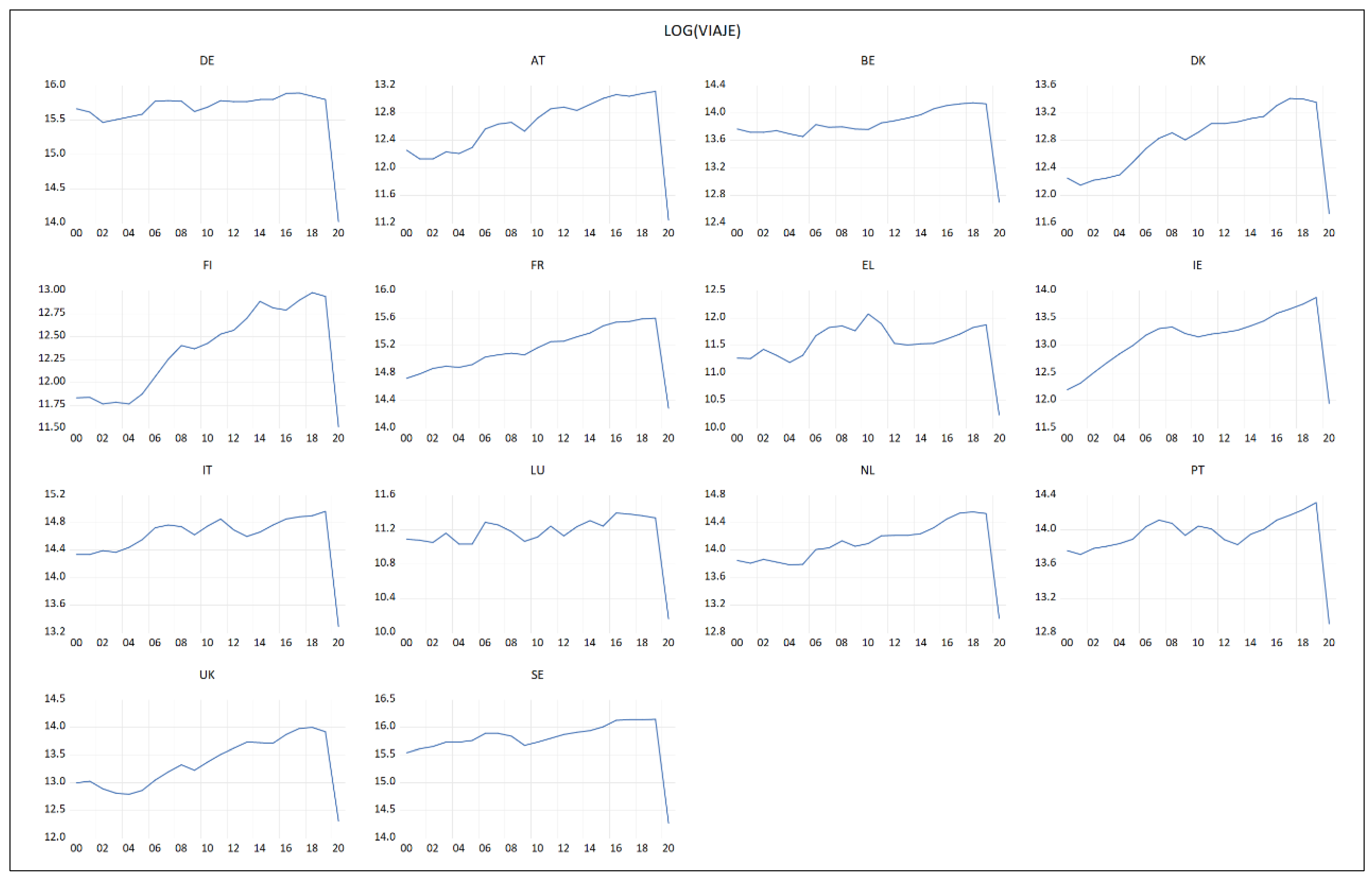
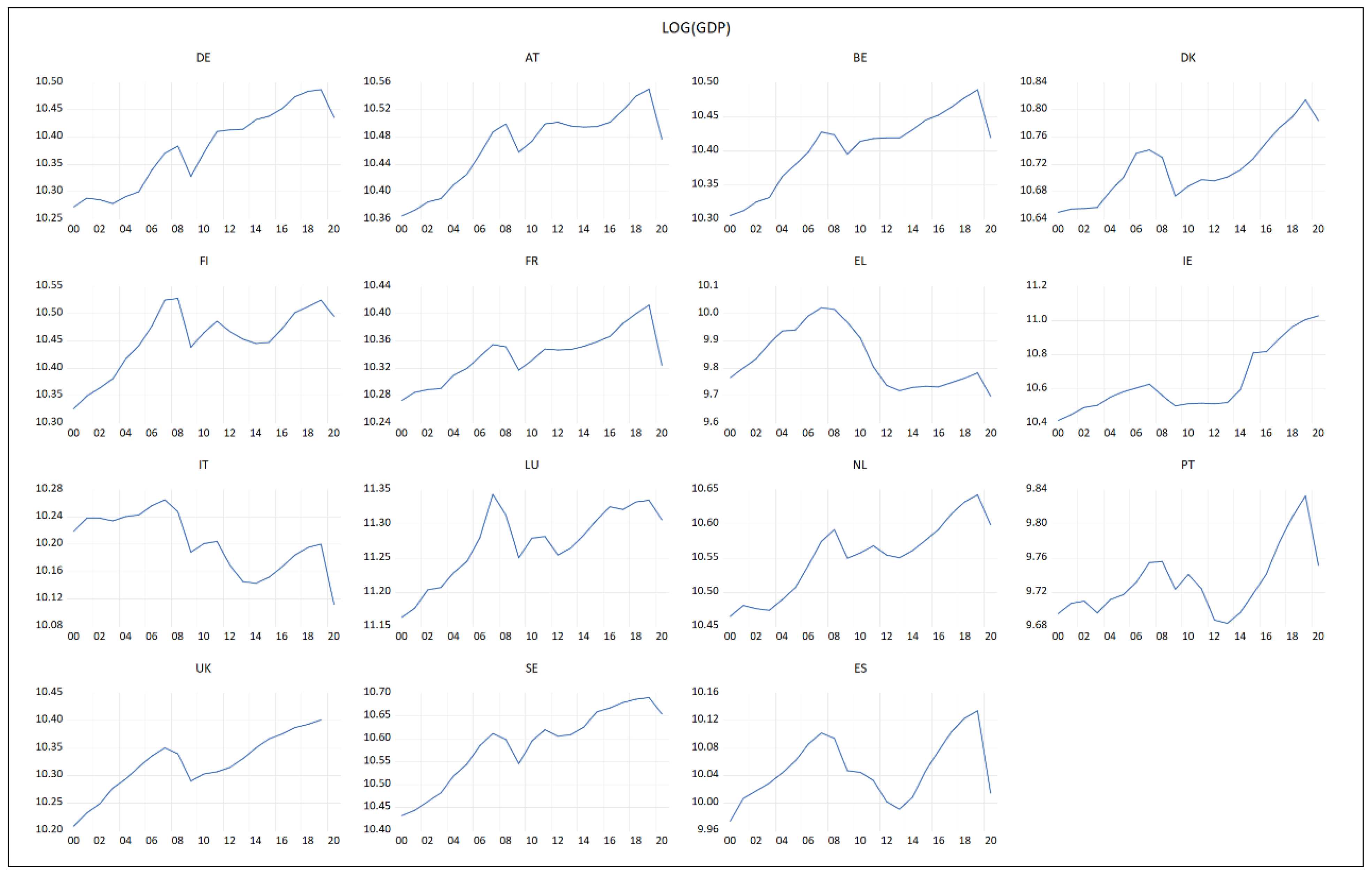
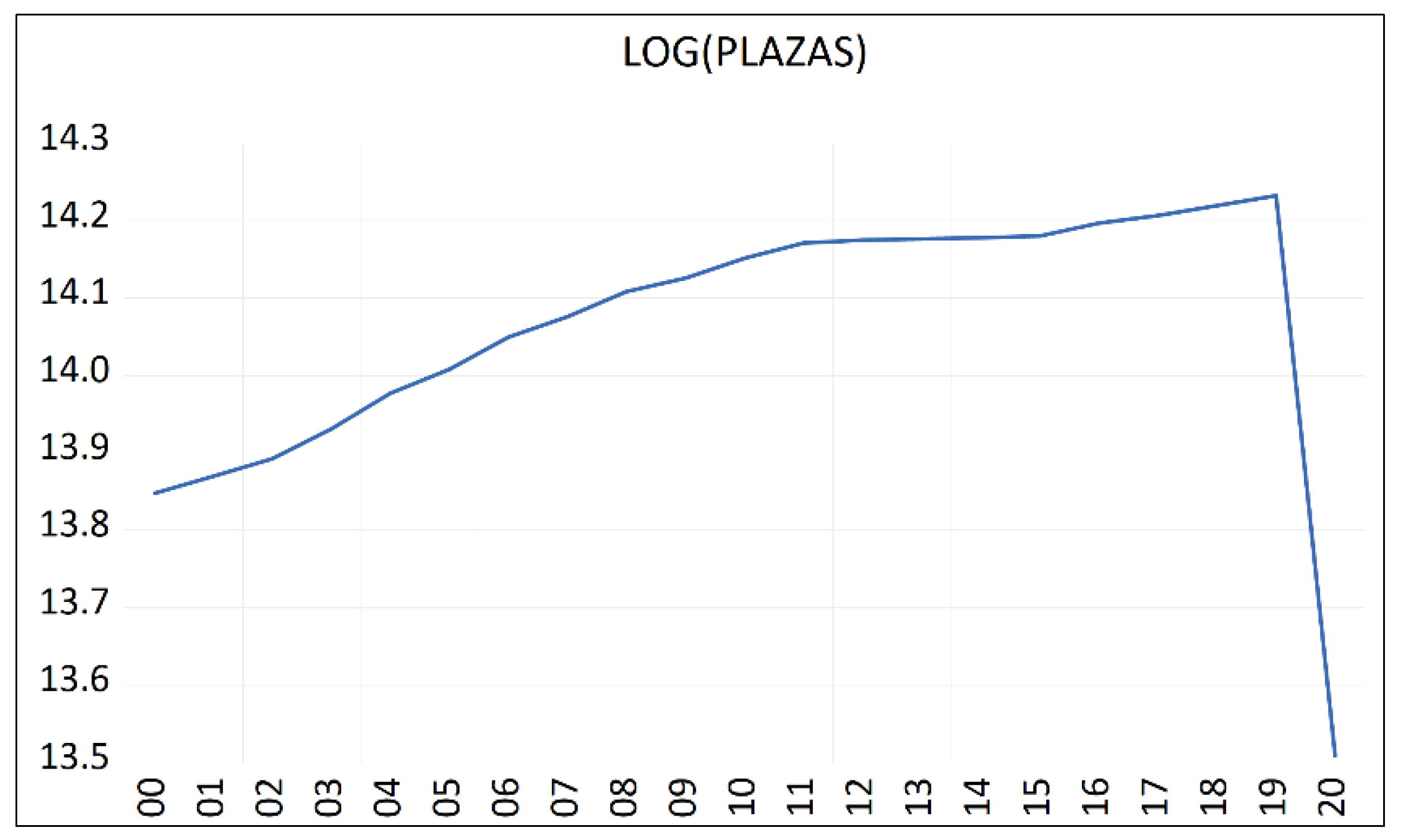
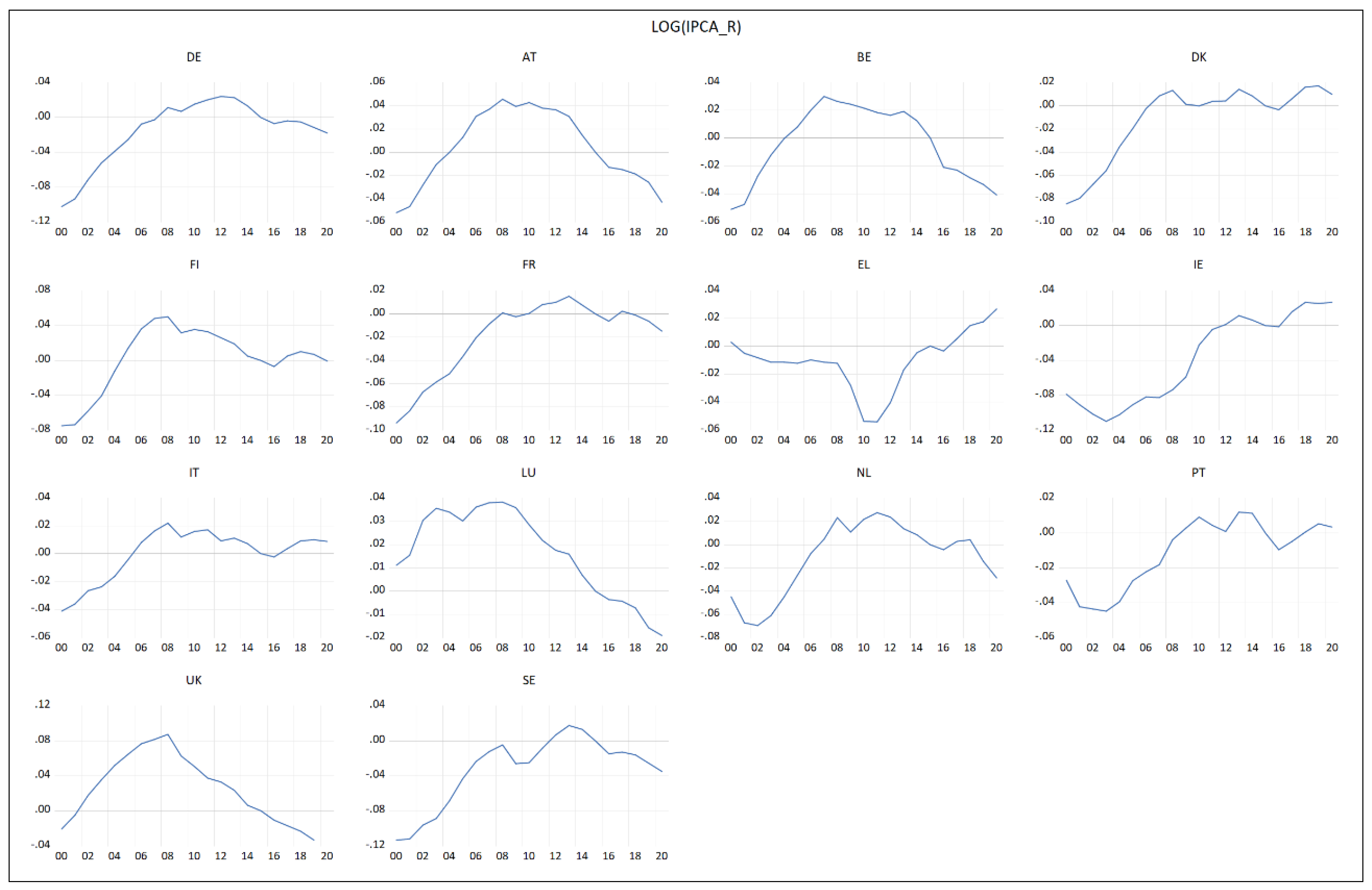
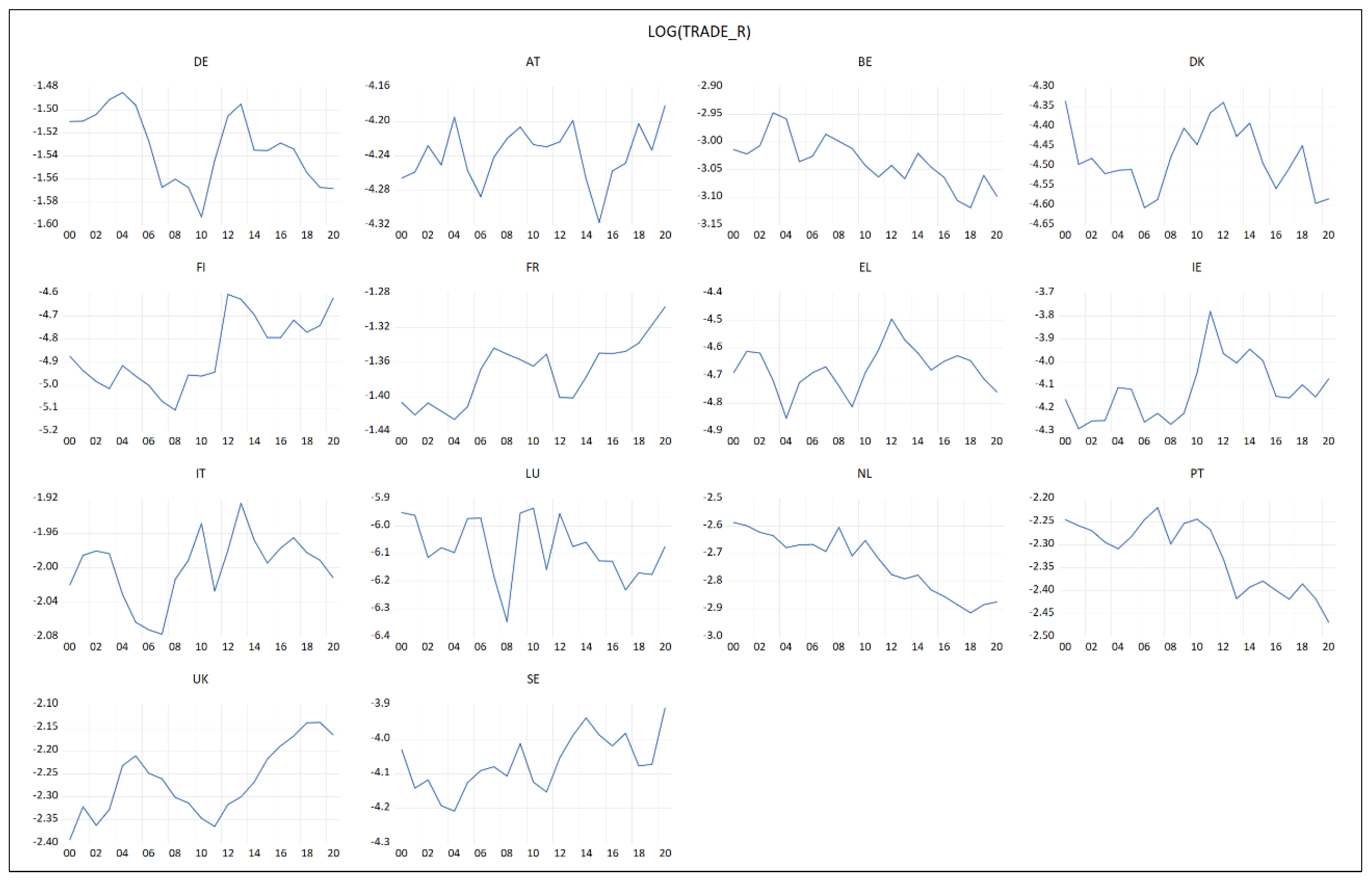
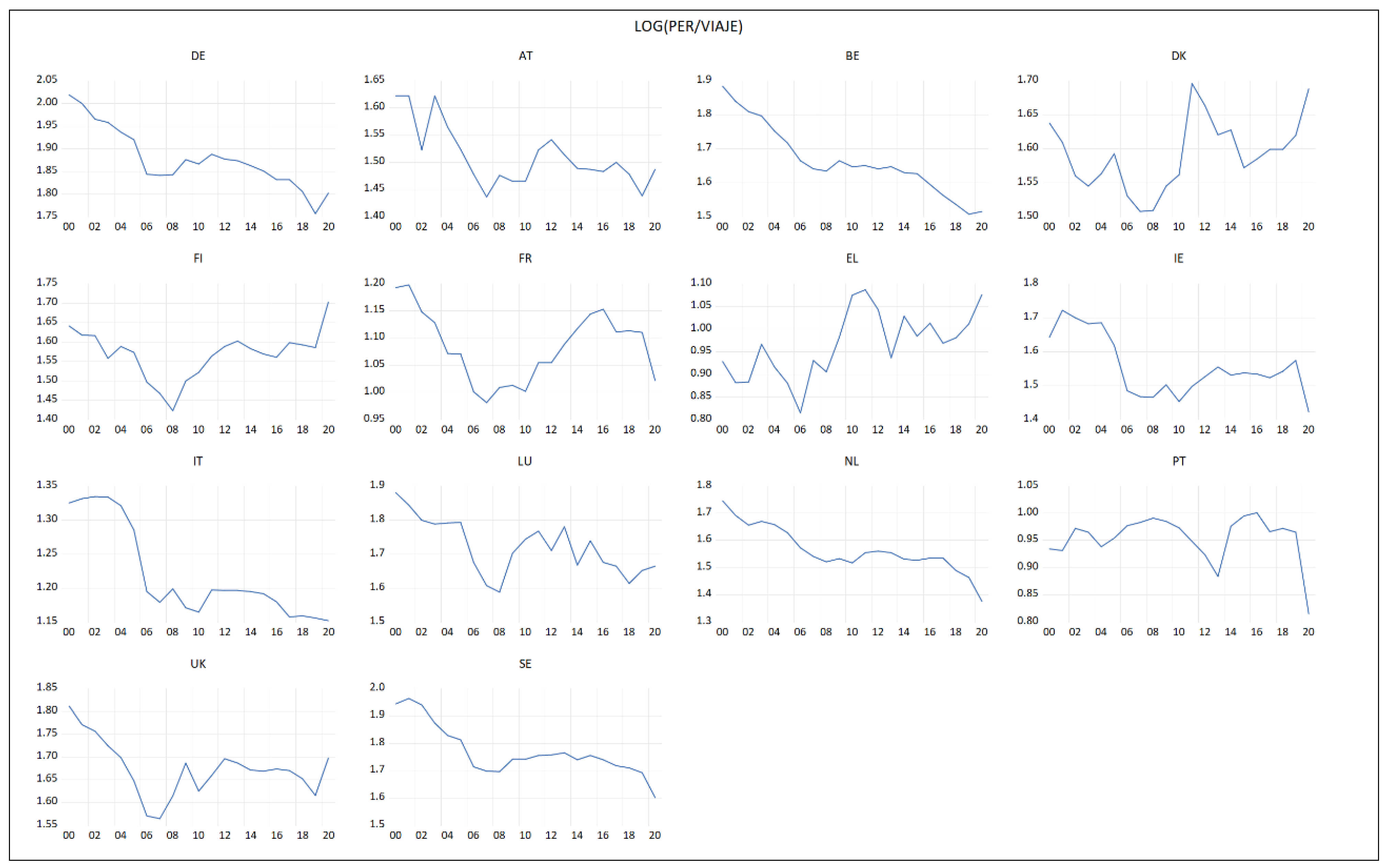
Appendix B. Statistical Results
| Descriptive Statistics | TRAVEL | GDP | BEDS | RCPI_R | TRADE_R | OVER/TRAVEL |
|---|---|---|---|---|---|---|
| Mean | 1,870,356 | 35,982 | 1,295,703 | 0.9930 | 0.0714 | 4.5812 |
| Median | 909,010 | 33,920 | 1,363,934 | 1.0000 | 0.0335 | 4.7732 |
| Maximum | 10,351,685 | 84,420 | 1,517,583 | 1.0910 | 0.2735 | 7.5233 |
| Minimum | 25,886 | 16,050 | 735,619 | 0.8927 | 0.0018 | 2.2580 |
| Std. Dev. | 2,454,624 | 14,497 | 196,079 | 0.0348 | 0.0787 | 1.2428 |
| Skewness | 1.6887 | 1.6446 | −1.1443 | −0.6180 | 1.1654 | −0.1916 |
| Kurtosis | 4.7577 | 6.1865 | 3.8213 | 3.6358 | 3.1492 | 2.2157 |
| Jarque-Bera | 177.5768 | 256.0455 | 72.4229 | 23.5870 | 66.8214 | 9.3343 |
| Probability | 0.0000 | 0.0000 | 0.0000 | 0.0000 | 0.0000 | 0.0094 |
| Sum | 5.50 × 108 | 10,542,620 | 3.81 × 108 | 290.9396 | 21 | 1,346.866 |
| Sum Sq. Dev. | 1.77 × 1015 | 6.14 × 1010 | 1.13 × 1013 | 0.35443 | 1.816543 | 452.5722 |
| Observations | 294 | 293 | 294 | 293 | 294 | 294 |
| Null Hypothesis: Unit Root (Assumes Common Unit Root Process) | ||||
| Test | Statistic | p-Value | Cross-Sections | Obs. |
| Levin, Lin & Chu t | 5.28143 | 1.0000 | 14 | 275 |
| Null Hypothesis: Unit Root (Assumes Individual Unit Root Process) | ||||
| Test | Statistic | p-Value | Cross-Sections | Obs. |
| ADF—Fisher | 29.4387 | 0.3905 | 14 | 275 |
| PP—Fisher | 24.1512 | 0.6735 | 14 | 280 |
| Null Hypothesis: Unit Root (Assumes Common Unit Root Process) | ||||
| Test | Statistic | p-Value | Cross-Sections | Obs. |
| Levin, Lin & Chu t | −2.24359 | 0.0124 | 15 | 294 |
| Null Hypothesis: Unit Root (Assumes Individual Unit Root Process) | ||||
| Test | Statistic | p-Value | Cross-Sections | Obs. |
| ADF—Fisher | 37.4615 | 0.1641 | 15 | 294 |
| PP—Fisher | 32.3963 | 0.3493 | 15 | 299 |
| Null Hypothesis: Unit Root (Assumes Common Unit Root Process) | ||||
| Test | Statistic | p-Value | Cross-Sections | Obs. |
| Levin, Lin & Chu t | 1.34719 | 0.9110 | 1 | 20 |
| Null Hypothesis: Unit Root (Assumes Individual Unit Root Process) | ||||
| Test | Statistic | p-Value | Cross-Sections | Obs. |
| ADF—Fisher | 1.3707 | 0.5039 | 1 | 20 |
| PP—Fisher | 1.3707 | 0.5039 | 1 | 20 |
| Null Hypothesis: Unit Root (Assumes Common Unit Root Process) | ||||
| Test | Statistic | p-Value | Cross-Sections | Obs. |
| Levin, Lin & Chu t | −3.84960 | 0.0001 | 14 | 265 |
| Null Hypothesis: Unit Root (Assumes Individual Unit Root Process) | ||||
| Test | Statistic | p-Value | Cross-Sections | Obs. |
| ADF—Fisher | 46.8153 | 0.0143 | 14 | 265 |
| PP—Fisher | 37.8642 | 0.1010 | 14 | 279 |
| Null Hypothesis: Unit Root (Assumes Common Unit Root Process) | ||||
| Test | Statistic | p-Value | Cross-Sections | Obs. |
| Levin, Lin & Chu t | −1.44324 | 0.0745 | 14 | 277 |
| Null Hypothesis: Unit Root (Assumes Individual Unit Root Process) | ||||
| Test | Statistic | p-Value | Cross-Sections | Obs. |
| ADF—Fisher | 38.0566 | 0.0973 | 14 | 277 |
| PP—Fisher | 37.7307 | 0.1036 | 14 | 280 |
| Null Hypothesis: Unit Root (Assumes Common Unit Root Process) | ||||
| Test | Statistic | p-Value | Cross-Sections | Obs. |
| Levin, Lin & Chu t | −1.93379 | 0.0266 | 14 | 274 |
| Null Hypothesis: Unit Root (Assumes Individual Unit Root Process) | ||||
| Test | Statistic | p-Value | Cross-Sections | Obs. |
| ADF—Fisher | 36.0658 | 0.1409 | 14 | 274 |
| PP—Fisher | 29.9261 | 0.3668 | 14 | 280 |
| 1 | Many time series in macroeconomics are non-stationary or evolutionary and, as a general rule, regressions on levels of such series signify that standard significance tests are usually wrong, favouring so-called spurious regressions (Granger and Newbold 1974; Greene 1999; Granger and Newbold 1974; Greene 1999). |
| 2 | Engle and Granger (1987) highlighted that cointegrating variables can be transformed into an error correction mechanism (ECM) and vice versa. This bidirectional transformation is known as the “Granger Representation Theorem”. |
| 3 | A recent application of this methodology applied to trade flows between the European Union (EU) and Russia can be found in Garashchuk et al. (2021). |
| 4 | https://www.ine.es/jaxiT3/Tabla.htm?t=2038&L=0 (accessed on 5 April 2020). |
| 5 | https://www.ine.es/jaxiT3/Tabla.htm?t=2011&L=0 (accessed on 5 April 2020). |
| 6 | A unit root or stationary difference process is a stochastic trend in time series, known as a “random walk with drift”. If a time series has a unit root, it exhibits systematic behaviour that is unpredictable (https://www.statisticshowto.com/unit-root/, accessed on 24 January 2020). |
| 7 | If the variables are not cointegrated, the residuals of the static estimation will, by definition, have a unit root (i.e., they will not be stationary and have a time-varying character). |
| 8 | The two-stage procedure of Engle and Granger (1987) commences by first estimating the cointegrating relationship by ordinary least squares (OLS) (in this case, since it is a panel, it has been estimated by fixed effects). Subsequently, the ECM is estimated by introducing the residuals of the estimated cointegrating relationship lagged by one period. |
References
- Aissa, Sami Ben, and Mohamed Goaied. 2017. Performance of Tourism Destinations: Evidence From Tunisia. Journal of Hospitality & Tourism Research 41: 797–822. [Google Scholar]
- Albaladejo Pina, Isabel, and María Pilar Martinez-Garcia. 2013. An endogenous growth model of international tourism. Tourism Economics 19: 509–29. [Google Scholar]
- Alegre, Joaquín, Sara Mateo, and Llorenc Pou. 2009. Participation in tourism consumption and the intensity of participation: An analysis of their socio-demographic and economic determinants. Tourism Economics 15: 531–46. [Google Scholar] [CrossRef]
- Alleyne, Laron, Ohno Okey, and Winston Moore. 2021. The volatility of tourism demand and real effective exchange rates: A disaggregated analysis. Tourism Review 76: 489–502. [Google Scholar] [CrossRef]
- Ana, María-Irina. 2018. Tourism industry in the new member states. Key countries and destinations. Management & Marketing. Challenges for the Knowledge Society 13: 812–30. [Google Scholar]
- Antonakakis, Nikolaos, Mina Dragouni, Bruno Eeckels, and Georg Filis. 2016. Tourism and economic growth: Does democracy matter? Annals of Tourism Research 61: 258–64. [Google Scholar] [CrossRef]
- Arbulú, Italo, María Razumova, Javier Rey-Maquieira, and Francesc Sastre. 2021. Can domestic tourism relieve the COVID-19 tourist industry crisis? The case of Spain. Journal of Destination Marketing & Management 20: 100568. [Google Scholar] [CrossRef]
- Balaguer, Jacint, and Manuel Cantavella-Jordá. 2002. Tourism as a long-run economic growth factor: The Spanish case. Applied Economics 34: 877–84. [Google Scholar] [CrossRef]
- Balcilar, Mehmet, Sahar Aghazadeh, and Georg Ike. 2020. Modelling the employment, income and price elasticities of outbound tourism demand in OECD countries. Tourism Economics 27: 971–90. [Google Scholar] [CrossRef]
- Baltagi, Badi Hani. 2013. Econometric Analysis of Panel Data, 5th ed. Chichester: Wiley. [Google Scholar]
- Bárcena-Martin, Elena, Mercedes Rodriguez-Fernandez, and Susana Borrego-Dominguez. 2017. Golf, supply and demand: The influence of economic factors. Tourism Economics 23: 1220–34. [Google Scholar] [CrossRef]
- Barro, Robert, and José Ursúa. 2017. Stock-market crashes and depressions. Research in Economics 71: 384–98. [Google Scholar] [CrossRef]
- Brida, Juan Gabriel, David Matesanz Gómez, and Verónica Segarra. 2020. On the empirical relationship between tourism and economic growth. Tourism Management 81: 104131. [Google Scholar] [CrossRef]
- Brida, Juan Gabriel, Juan Sebastian Pereyra, María Jesús Such Devesa, and Sandra Zapata Aguirre. 2008. La contribución del Turismo al Crecimiento Económico. Cuadernos de Turismo 22: 35–46. [Google Scholar]
- Bronner, Fred, and Robert de Hoog. 2016. Crisis Resistance of Tourist Demand: The Importance of Quality of Life. Journal of Travel Research 55: 190–204. [Google Scholar] [CrossRef]
- Chan, Felix, and Christine Lim. 2011. Tourism stock performance and macro factors. Paper Presented at MSSANZ 19th Biennial Congress on Modelling and Simulation (MODSIM), Perth, Australia, December 12–16; pp. 1596–602. [Google Scholar]
- Chau, Salott, and Libo Yan. 2021. Destination hospitality indicators. Journal of Destination Marketing & Management 19: 100537. [Google Scholar] [CrossRef]
- Chen, Ji, Fengming Cui, Tomas Balezentis, Dalia Streimikiene, and Huanhuan Jin. 2021. What drives international tourism development in the Belt and Road Initiative? Journal of Destination Marketing & Management 19: 100544. [Google Scholar]
- Cossio-Silva, Francisco José, María Ángeles Revilla-Camacho, and Manuela Vega-Vazquez. 2019. The tourist loyality index: A new indicator for measuring tourist destination loyalty? Journal of Innovation & Knowledge 4: 71–77. [Google Scholar]
- Cró, Susana, and Antonio Miguel Martins. 2017. Structural breaks in international tourism demand: Are they caused by crises or disasters? Tourism Management 63: 3–9. [Google Scholar] [CrossRef]
- Cruz-Ruiz, Elena, Elena Ruiz-Romero de la Cruz, and Lidia Caballero-Galeote. 2022. Recovery Measures for the Tourism Industry in Andalusia: Residents as Tourist Consumers. Economies 10: 133. [Google Scholar] [CrossRef]
- Danish, and Zhaohua Wang. 2018. Dynamic relationship between tourism, economic growth, and environmental quality. Journal of Sustainable Tourism 26: 1928–43. [Google Scholar] [CrossRef]
- Das, Jayoti, and Cassandra Dirienzo. 2010. Tourism competitiveness and corruption: A cross-country analysis. Tourism Economics 16: 477–92. [Google Scholar] [CrossRef]
- Datacomex. 2021. Estadísticas de Comercio exterior de Bienes de España y la UE. Madrid: Web de la Secretaría de Estado de Comercio de Estadísticas de Comercio Exterior de Mercancías de España. [Google Scholar]
- Demelas, Riccardo. 2009. Los Determinantes de la Demanda Turística y sus Implicaciones en Término de Estacionalidad. Barcelona: Departament D’economia Aplicada, Universidad Autónoma de Barcelona. [Google Scholar]
- Dickey, David. 1979. Distribution of the Estimators for Autorregressive Time Series with a Unit Root. Journal of the American Statistical Association 74: 427–31. [Google Scholar]
- Dolnicar, Sara, Venkata Yanamandram, and Katie Cliff. 2012. The contribution of vacations to quality of life. Annals of Tourism Research 39: 59–83. [Google Scholar]
- Dritsakis, Nikolaos. 2012. Tourism development and economic growth in seven Mediterranean countries: A panel data approach. Tourism Economics 18: 801–16. [Google Scholar] [CrossRef]
- Engle, Robert, and Clive William Granger. 1987. Co-Integration and Error Correction: Representation, Estimation, and Testing. Econometrica 55: 251–76. [Google Scholar] [CrossRef]
- Eugenio-Martin, Juan Luis. 2003. Modelling determinants of tourism demand as a five-stage process: A discrete choice methodological approach. Tourism and Hospitality Research 4: 341–54. [Google Scholar] [CrossRef]
- Eugenio-Martin, Juan Luis, and Juan Campos-Soria. 2011. Income and the substitution pattern between domestic and international tourism demand. Applied Economics, Taylor & Francis Journals 43: 2519–31. [Google Scholar]
- Falk, Martin, and Markku Vieru. 2019. International tourism demand to Finnish Lapland in the early winter season. Current in Tourism 22: 1312–26. [Google Scholar] [CrossRef]
- Fu, Xiaoxiao, Jorge Ridderstaat, and Helen Jia. 2020. Are all tourism markets equal? Linkages between market-based tourism demand, quality of life, and economic development in Hong Kong. Tourism Management 77: 104015. [Google Scholar]
- Garashchuk, Anna, Fernando Isla, and Pablo Podadera. 2021. The Empirical Evidence of the EU–Russia Failed Strategic Partnership: Did it have a Positive Impact on Bilateral Trade? European Review 29: 1–29. [Google Scholar] [CrossRef]
- García-Sánchez, Antonio, Ester Fernández-Rubio, and María Dolores Collado. 2013. Daily Expenses of Foreign Tourists, Length of Stay and Activities: Evidence from Spain. Tourism Economics 19: 613–30. [Google Scholar] [CrossRef]
- Gómez-Vega, Mafalda, and Luis César Herrero-Prieto. 2018. Achieving tourist destination competitiveness: Evidence from Latin-American and Caribbean countries. International Journal of Tourism Research 20: 782–95. [Google Scholar] [CrossRef]
- Granger, Clive William, and Paul Newbold. 1974. Spurious Regressions in Econonemetrics. Journal of Econometrics 2: 111–20. [Google Scholar]
- Greene, W. 1999. Análisis Econométrico. Madrid: Prentice Hall. [Google Scholar]
- Guo, Kun, Wei-Xing Zhou, Si-Wei Cheng, and Didier Sornette. 2011. The US Stock Market Leads the Federal Funds Rate and Treasury Bond Yields. PLoS ONE 6: e22794. [Google Scholar] [CrossRef] [PubMed]
- Habibi, Fateh. 2017. The determinants of inbound tourism to Malaysia: A panel data analysis. Current Issues in Tourism 20: 909–30. [Google Scholar] [CrossRef]
- Hall, Michael. 2010. Crisis events in tourism: Subjects of crisis in tourism. Current Issues in Tourism 13: 401–17. [Google Scholar]
- Hanafiah, Mohd Hafiz, and Mohd Fauzi Harun. 2010. Tourism Demand in Malaysia: A cross-sectional pool time-series analysis. International Journal of Trade, Economics and Finance 1: 80–83. [Google Scholar]
- Hanafiah, M., M. Harun, and M. Jamaluddin. 2011. Trade and Tourism Demand: A Case of Malaysia. Business and Economics Research 1: 1–4. [Google Scholar]
- Hill, R. Carter, William Griffiths, and Guay Lim. 2018. Principles of Econometrics, 5th ed. Hoboken: John Wiley & Sons, Inc. [Google Scholar]
- Hon, Alice, and Clare Fung. 2019. A Good Night’s Sleep Matters for Tourists: An Empirical Study for Hospitality Professionals. Journal of Hospitality & Tourism Research 43: 1153–75. [Google Scholar]
- Hsing, Yu, and Wen-jen Hsieh. 2012. Impacts of macroeconomic variables on the stock market index in Poland: New evidence. Journal of Business Economics and Management 13: 334–43. [Google Scholar] [CrossRef]
- Husein, Jamal, and S. Murat Kara. 2020. Nonlinear ARDL estimation of tourism demand for Puerto Rico from the USA. Tourism Management 77: 103998. [Google Scholar] [CrossRef]
- Im, Jongho, Jewoo Kim, and Joon Yeon Choeh. 2021. COVID-19, social distancing, and risk-averse actions of hospitality and tourism consumers: A case of South Korea. Journal of Destination Marketing & Management 20: 100566. [Google Scholar] [CrossRef]
- INE. 2019. Cuenta Satélite del Turismo de España (CSTE). Revisión Estadística 2019 Serie 2016—2018. Notas de Prensa. Madrid: INE. [Google Scholar]
- INE. 2020. Cuenta Satélite del Turismo de España (CSTE). Revisión Estadística 2019 Serie 2016–2019. Madrid: INEbase. [Google Scholar]
- INE. 2021. www.ine.es. Available online: https://www.ine.es/daco/daco42/frontur/frontur1220.pdf (accessed on 24 May 2021).
- Işık, Cem, Magdalena Radulescu, and Aleksandra Fedajev. 2019. The effects of exchange rate depreciations and appreciations on the tourism trade balance: The case of Spain. Eastern Journal of European Studies 10: 221–37. [Google Scholar]
- Ivanov, Stanislav Hristov, and Craig Webster. 2013. Tourism’s impact on growth: The role of globalisation. Annals of Tourism Research 41: 231–36. [Google Scholar] [CrossRef]
- Khalid, Usman, Luke Emeka Okafor, and Muhammad Shafiullah. 2020. The Effects of Economic and Financial Crises on International Tourist Flows: A Cross-Country Analysis. Journal of Travel Research 59: 315–34. [Google Scholar] [CrossRef]
- Khanna, Rupika, and Chandan Sharma. 2021. Does Financial Development Raise Tourism Demand? A Cross-Country Panel Evidence. Journal of Hospitality and Tourism Research. [Google Scholar] [CrossRef]
- Kim, Hong-bumm, Jung-Ho Park, Seul Ki Lee, and SooCheong Shawn Jang. 2012. Do expectations of future wealth increase outbound tourism? Evidence from Korea. Tourism Management 33: 1141–47. [Google Scholar] [CrossRef]
- Konstantakopoulou, Ioanna. 2022. Does health quality affect tourism? Evidence from system GMM estimates. Economic Analysis and Policy 73: 425–40. [Google Scholar] [CrossRef]
- Kumar, Nikeel, Ronald Ravinesh Kumar, Radika Kumar, and Peter Josef Stauvermann. 2020. Is the tourism-growth relationship asymmetric in the Cook Islands? Evidence from NARDL cointegration and causality tests. Tourism Economics 26: 658–81. [Google Scholar] [CrossRef]
- Machado, Virgilio, Joaquim Contreiras, and Ana Patricia Duarte. 2019. Local tourist accommodation and institutional strengthening in the interior of the Algarve, Portugal The role of legislation and technology. Journal of Place Management and Development 13: 255–72. [Google Scholar] [CrossRef]
- Mariolis, Theodore, Nikolaos Rodousakis, and George Soklis. 2020. The COVID-19 multiplier effects of tourism on the Greek economy. Tourism Economics 27: 1848–55. [Google Scholar] [CrossRef]
- Martins, Luís Filipe, Yi Gan, and Alexandra Ferreira-Lopes. 2017. An empirical analysis of the influence of macroeconomic determinants on World tourism demand. Tourism Management 61: 248–60. [Google Scholar] [CrossRef]
- Montano, Juan José, Jaume Rossello, and Andreu Sanso. 2019. A new method for estimating tourists’ length of stay. Tourism Management 75: 112–20. [Google Scholar] [CrossRef]
- Murgoci, Cristiana, Daniela Firoiu, Emilia Ionescu, and Stephan Alexandru Ionescu. 2009. Global Recession and its effects on Tourism and Travel Industry. Paper Presented at 20th International Danube-Adria-Association-for-Automation-and-Manufacturing, Annals of DAAAM and Proceedings, Vienna, Austria, November 25–29, vol. 20, pp. 1573–74. [Google Scholar]
- Muryani, Muryani, Mia Fauzia Permatasari, and Miguel Angel Esquivias. 2020. Determinants Of Tourism Demand In Indonesia: A Panel Data Analysis. Tourism Analysis 25: 77–89. [Google Scholar] [CrossRef]
- Nepal, Rabindra, Muhammad Indra al Irsyad, and Sanjay Nepal. 2019. Tourist arrivals, energy consumption and pollutant emissions in a developing economy–implications for sustainable tourism. Tourism Management 72: 145–54. [Google Scholar] [CrossRef]
- Nicolau, Juan Luis, and Francisco Mas. 2005. Heckit modelling of tourist expenditure: Evidence from Spain International. Journal of Service Industry Management 16: 271–93. [Google Scholar]
- Nguyen, Quang Hai. 2022. Tourism Demand Elasticities by Income and Prices of International Market Regions: Evidence Using Vietnam’s Data. Economies 10: 1. [Google Scholar] [CrossRef]
- Oliveira, Margarida, Eulalia Santos, and Susana Rodrigues. 2019. Motivational and Attraction Factors of Tourists in the Central Region of Portugal. Paper Presented at 2nd International Conference On Tourism Research (ICTR 2019), Porto, Portugal, March 14–15; Porto: Academic Conferences International Limited, pp. 198–207. [Google Scholar]
- Ongan, Serdar, Cem Işik, and Dilek Özdemir. 2017. The Effects of Real Exchange Rates and Income on International Tourism Demand for the USA from Some European Union Countries. Economies 5: 51. [Google Scholar] [CrossRef]
- Opstad, Leiv, Randi Hammervold, and Johannes Idsø. 2021. The Influence of Income and Currency Changes on Tourist Inflow to Norwegian Campsites: The Case of Swedish and German Visitors. Economies 9: 104. [Google Scholar] [CrossRef]
- Parte-Esteban, Laura, and Pilar Alberca-Oliver. 2015. Determinants of technical efficiency in the Spanish hotel industry: Regional and corporate performance factors. Current Issues in Tourism 18: 391–411. [Google Scholar]
- Peng, Grace, Haiyan Song, Geoffrey Crouch, and Stephen Witt. 2015. A Meta-Analysis of International Tourism Demand Elasticities. Journal of Travel Research 54: 611–33. [Google Scholar] [CrossRef]
- Perles-Ribes, José Francisco, Ana Belén Ramón-Rodríguez, María Jesús Such-Devesa, and Luis Moreno-Izquierdo. 2019. Effects of political instability in consolidated destinations: The case of Catalonia (Spain). Tourism Management 70: 134–39. [Google Scholar] [CrossRef]
- Pompili, Tomaso, Maurizio Pisati, and Eleonora Lorenzini. 2019. Determinants of international tourist choices in Italian provinces: A joint demand-supply approach with spatial effects. Papers in Regional Science 98: 2251–73. [Google Scholar] [CrossRef]
- Popescu, Agatha. 2019. Trends and Correlations between Accomodation Capacity and Tourist Flows in the EU-28 Top 10 Tourist Destinations in the Period 2008–2017. Paper Presented at 33rd International Business Information Management Association Conference, Granada, Spain, April 11; pp. 1253–70. [Google Scholar]
- Popescu, Agatha, and Daniela Plesoianu. 2017. Trends of Tourist Arrivals and Overnight Stays in the Maramures County, Romania, 2007–2016 and Forecast for 2017–2021. Scientific Papers Series Management, Economic Engineering in Agriculture and Rural Development, Volume 17, Issue 4. Tallinn: EurekaMag. [Google Scholar]
- Ritchie, Brent, Carlos Mario Molinar, and Douglas Frechtling. 2010. Impacts of the World Recession and Economic Crisis on Tourism: North America. Journal of Travel Research 49: 5–15. [Google Scholar] [CrossRef]
- Saito, Hisamitsu, and João Romão. 2018. Seasonality and regional productivity in the Spanish accommodation sector. Tourism Management 69: 180–88. [Google Scholar] [CrossRef]
- Sánchez-Teba, Eva María, Josefa García-Mestanza, and Mercedes Rodríguez-Fernández. 2020. The Application of the Inbound Marketing Strategy on Costa del Sol Planning & Tourism Board. Lessons for Post-COVID-19 Revival. Sustainability 12: 9926. [Google Scholar] [CrossRef]
- Santamaria, Daniel, and George Filis. 2019. Tourism demand and economic growth in Spain: New insights based on the yield curve. Tourism Management 75: 447–59. [Google Scholar] [CrossRef]
- Santana-Gallego, María, Francisco Ledesma-Rodríguez, and Jorge Pérez-Rodríguez. 2011. Tourism and trade in OECD countries, a dynamic heterogeneous panel data analysis. Empirical Economics 41: 533–54. [Google Scholar] [CrossRef]
- Santos, Glauber Eduardo de Oliveira, Vicente Ramos, and Javier Rey-Maquieira. 2015. Length of Stay at Multiple Destinations of Tourism Trips in Brazil. Journal of Travel Research 54: 788–800. [Google Scholar] [CrossRef]
- Sargan, Jhon Denis. 1984. Wages and Prices in the United Kingdom: A Study in Econometric Methodology. Quantitative Economics and Econometric Analysis 16: 25–54. [Google Scholar]
- Schubert, Stefan Franz, Juan Gabriel Brida, and Wiston Adrián Risso. 2011. The impacts of international tourism demand on economic growth of small economies dependent on tourism. Tourism Management 32: 377–85. [Google Scholar] [CrossRef]
- Senbeto, Dagnachew Leta, and Alice Hon. 2020. The impacts of social and economic crises on tourist behaviour and expenditure: An evolutionary approach. Current Issues in Tourism 23: 740–55. [Google Scholar] [CrossRef]
- Sequeira, Tiago Neves, and Paulo Maçãs Nunes. 2008. Does tourism influence economic growth? A dynamic panel data approach. Applied Economics 40: 2431–41. [Google Scholar] [CrossRef]
- Song, Haiyan, Gang Li, Stephen Witt, and Baogang Fei. 2010. Tourism demand modelling and forecasting: How should demand be measured? Tourism Economics 16: 63–81. [Google Scholar] [CrossRef]
- Song, Haiyan, Gang Li, Stephen Witt, and Xinyan Zhang. 2011. Impact of financial/economic crisis on demand for hotel rooms in Hong Kong. Tourism Management 32: 172–86. [Google Scholar] [CrossRef]
- Song, Haiyan, Stephen Witt, and Gang Li. 2012. The Advanced Econometrics of Tourism Demand. Routledge Advances in Tourism. London: Routledge. [Google Scholar]
- Sönmez, Sevil, and Alan Graefe. 1998. Influence of Terrorism Risk on Foreign Tourism Decisions. Annals of Tourism Research 25: 112–44. [Google Scholar] [CrossRef]
- Stauvermann, Peter Joseph, and Ronald Ravinesh Kumar. 2017. Productivity growth and income in the tourism sector: Role of tourism demand and human capital investment. Tourism Management 61: 426–33. [Google Scholar] [CrossRef]
- Surugiu, Camelia, Nuno Carlos Leitão, and Marius Surugiu. 2011. A PanelData Modelling of International Tourism Demand: Evidences for Romania. Economic Research 24: 134–45. [Google Scholar]
- Tang, Chor Foon, and Eu Chye Tan. 2017. Tourism-Led Growth Hypothesis: A New Global Evidence. Cornell Hospitality Quarterly 59: 304–11. [Google Scholar] [CrossRef]
- Turner, Lindsay, and Stephen Witt. 2001. Factors Influencing Demand for International Tourism: Tourism Demand Analysis Using Structural Equation Modelling. Tourism Economics 7: 21–38. [Google Scholar] [CrossRef]
- Ulucak, Recep, Ali Yücel, and Salih İlkay. 2020. Dynamics of Tourism Demand in Turkey: Panel Data Analysis Using Gravity Model. Tourism Economics 25: 1–10. [Google Scholar] [CrossRef]
- UNWTO. 2019. Notas Metodológicas de la Base de Datos de Estadísticas de Turismo, Edición 2019. Madrid: World Tourism Organization. [Google Scholar]
- UNWTO. 2021a. Available online: https://www.unwto.org/es/onu-turismo-noticias-21 (accessed on 3 February 2020).
- UNWTO. 2021b. International Tourism Highlights. Madrid: OMT. [Google Scholar]
- Vergori, Anna Serena. 2017. Patterns of seasonality and tourism demand forecasting. Tourism Economics Tourism Economics 23: 1011–27. [Google Scholar] [CrossRef]
- Vila, Trinidad D., Elisa A. González, Noelia A. Vila, and Jose A.F. Brea. 2021. Indicators of Website Features in the User Experience of E-Tourism Search and Metasearch Engines. Journal of Theoretical and Applied Electronic Commerce Research 16: 18–36. [Google Scholar] [CrossRef]
- Villacé-Molinero, Teresa, Juan José Fernández-Muñoz, Alicia Orea-Giner, and Laura Fuentes-Moraleda. 2021. Understanding the new post-COVID-19 risk scenario: Outlooks and challenges for a new era of tourism. Tourism Management 86: 104324. [Google Scholar] [CrossRef]
- Wang, Yu-Shan. 2009. The impact of crisis events and macroeconomic activity on Taiwan’s international inbound tourism demand. Tourism Management 30: 75–82. [Google Scholar] [CrossRef]
- Wong, Ipkin Anthony, Lawrence Fong, and Rob Law. 2016. A Longitudinal Multilevel Model of Tourist Outbound Travel Behavior and the Dual-Cycle Model. Journal of Travel Research 55: 957–70. [Google Scholar] [CrossRef]
- Xie, Gang, Yatong Qian, and Shouyang Wang. 2021. Forecasting Chinese cruise tourism demand with big data: An optimized machine learning approach. Tourism Management 82: 104208. [Google Scholar] [CrossRef]
- Yazdi, Soheila Khoshnevis, and Bahman Khanalizadeh. 2017. Tourism demand: A panel data approach. Current Issues in Tourism 20: 787–800. [Google Scholar] [CrossRef]
- Zamparini, Luca, Anna Serena Vergori, and Serena Arima. 2017. Assessing the determinants of local tourism demand: A simultaneous equations model for the Italian provinces. Tourism Economics 23: 981–92. [Google Scholar] [CrossRef]
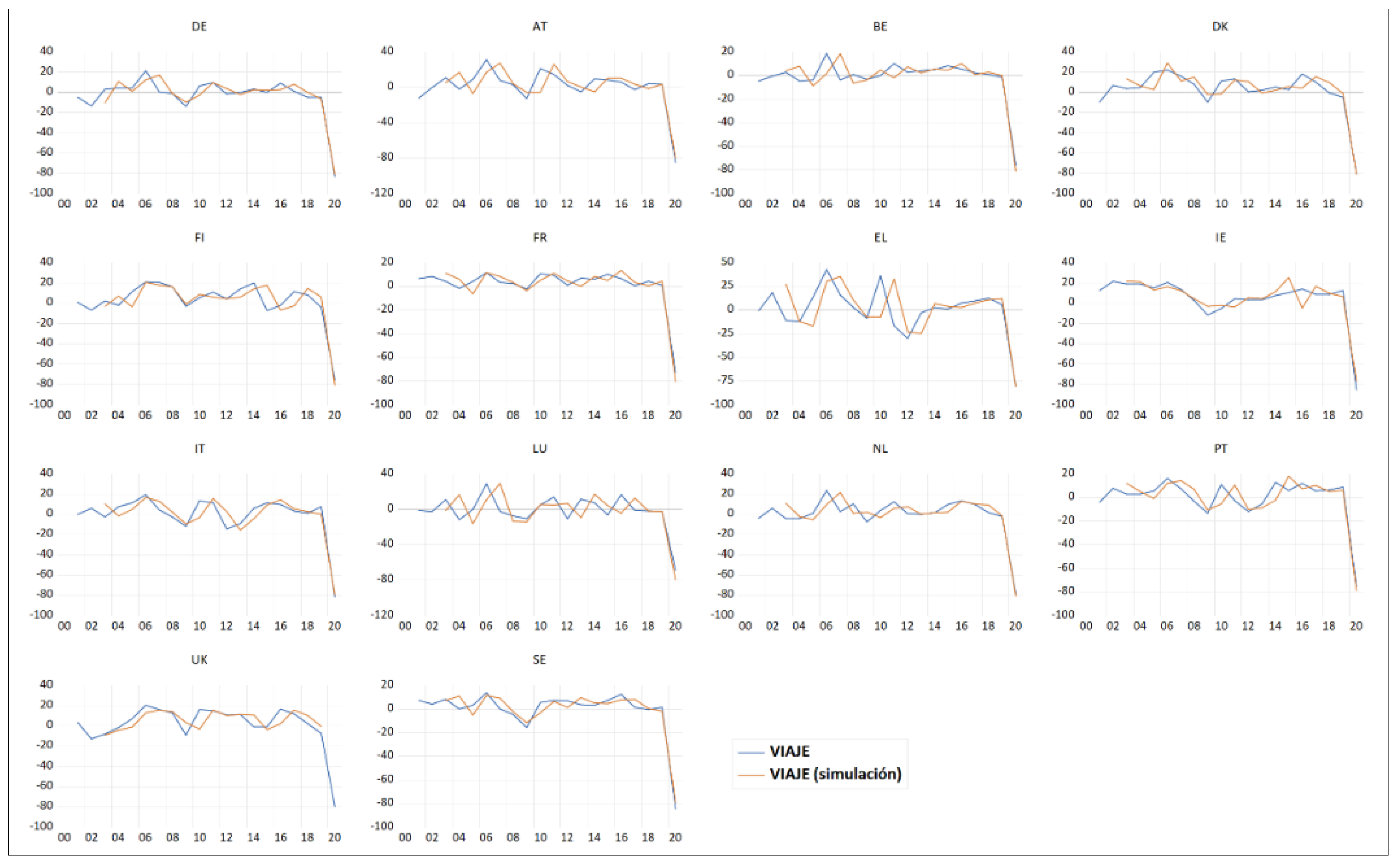
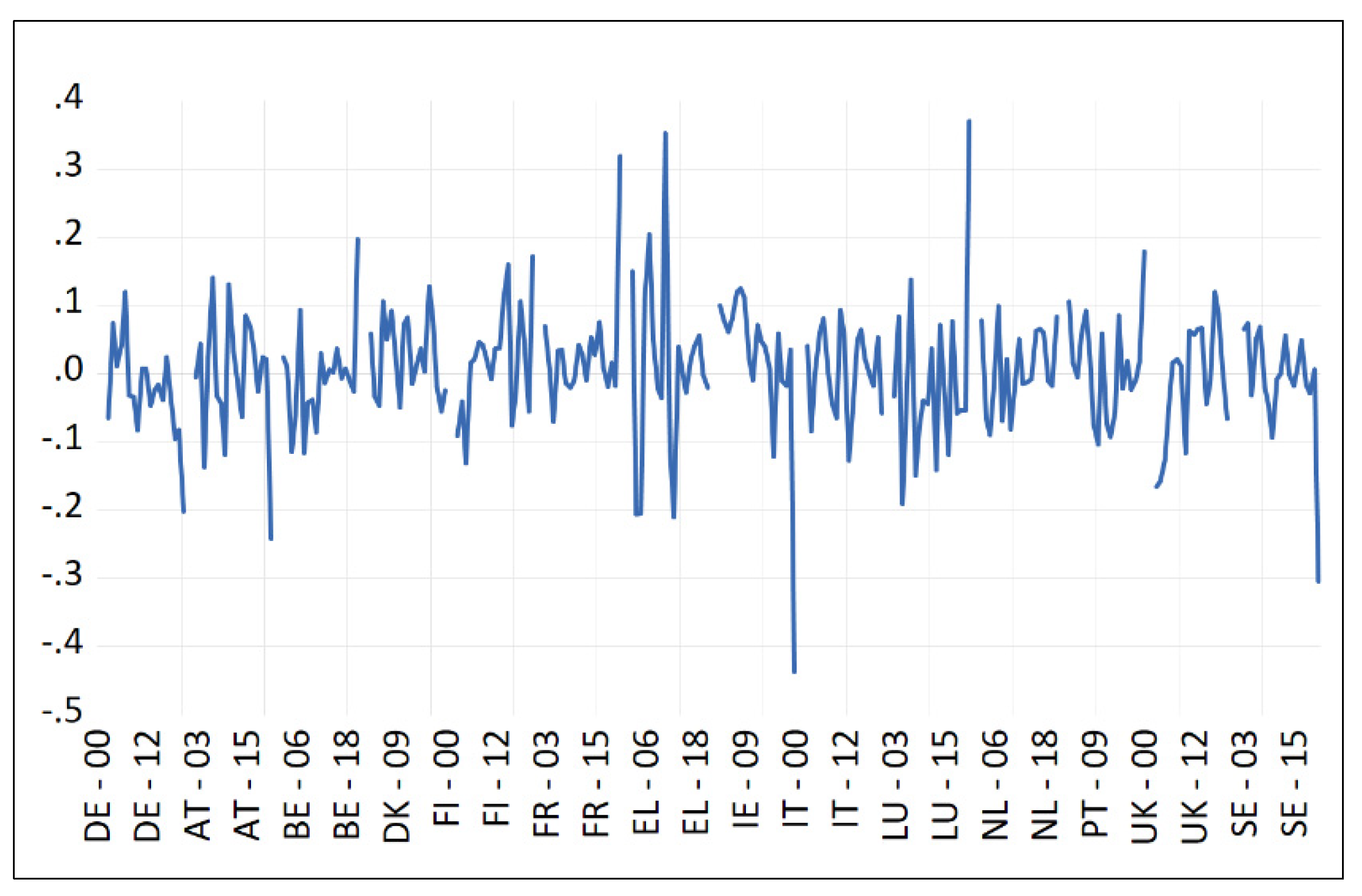
| Abbreviation | Description | Source |
|---|---|---|
| Log(TRAVELit) | Endogenous variable. All persons, classified by their country of residence, who make one or more consecutive overnight stays in the same accommodation in Spain. | INE4 |
| Log(GDPit) | Exogenous variable. Real gross domestic product per capita. | Eurostat |
| Log(BEDSit) | Exogenous variable. Estimated places equivalent to the number of fixed beds in the establishments. | INE5 |
| Log(RCPI_Rit) | Exogenous variable. Harmonised Index of Relative Consumer Prices. | INE |
| Log(TRADE_Rit) | Exogenous variable. Trade flows (exports minus imports of goods) between Spain and the EU. | Datacomex |
| Log(OVER/TRAVELit) | Exogenous variable. Variable resulting from dividing the number of overnight stays by the number of travellers in Spain. | INE |
| Log(INDEXit) | Exogenous variable. It represents the most significant stock market index in each country. | Official web pages |
| Dependent Variable: log(TRAVELit) | |||
|---|---|---|---|
| Independent Variable | Coefficient | t-Statistic | p-Value |
| LOG(GDPit) | 1.2440 | 8.1285 | 0.0000 |
| LOG(BEDSit) | 2.0629 | 33.0575 | 0.0000 |
| LOG(RCPI_Rit) | −1.6422 | −5.8289 | 0.0000 |
| LOG(TRADE_Rit) | 0.3116 | 2.2072 | 0.0281 |
| LOG(OVERit/TRAVELit) | 0.8364 | 5.4270 | 0.0000 |
| Null Hypothesis: Unit Root (Assumes Common Unit Root Process) | |||||
| Model | Test | Statistic | p-Value | Cross-Sections | Obs. |
| LT | Levin, Lin & Chu t | −5.6931 | 0.0000 | 14 | 279 |
| Null Hypothesis: Unit Root (Assumes Individual Unit Root Process) | |||||
| Model | Test | Statistic | p-Value | Cross-Sections | Obs. |
| LT | ADF—Fisher | 68.8704 | 0.0000 | 14 | 279 |
| LT | PP—Fisher | 71.7263 | 0.0000 | 14 | 279 |
| Dependent Variable: ∆LOG(TRAVELit) | |||
|---|---|---|---|
| Independent Variable | Coefficient | t-Statistic | p-Value |
| LT | −0.1682 | −5.3112 | 0.0000 |
| ∆LOG(GDPit) | 1.0013 | 5.1324 | 0.0000 |
| ∆LOG(BEDSit) | 2.1032 | 56.4125 | 0.0000 |
| ∆LOG(BEDSit−1) | −1.0244 | −4.0428 | 0.0001 |
| ∆LOG(TRAVELit−1) | 0.2136 | 3.4032 | 0.0008 |
| Null Hypothesis: Unit Root (Assumes Common Unit Root Process) | |||||
| Model | Test | Statistic | p-Value | Cross-Sections | Obs. |
| MCE | Levin, Lin & Chu t | −6.13856 | 0.0000 | 14 | 251 |
| Null Hypothesis: Unit Root (Assumes Individual Unit Root Process) | |||||
| Model | Test | Statistic | p-Value | Cross-Sections | Obs. |
| MCE | ADF—Fisher | 94.6800 | 0.0000 | 14 | 251 |
| MCE | PP—Fisher | 107.875 | 0.0000 | 14 | 251 |
Publisher’s Note: MDPI stays neutral with regard to jurisdictional claims in published maps and institutional affiliations. |
© 2022 by the authors. Licensee MDPI, Basel, Switzerland. This article is an open access article distributed under the terms and conditions of the Creative Commons Attribution (CC BY) license (https://creativecommons.org/licenses/by/4.0/).
Share and Cite
Borrego-Domínguez, S.; Isla-Castillo, F.; Rodríguez-Fernández, M. Determinants of Tourism Demand in Spain: A European Perspective from 2000–2020. Economies 2022, 10, 276. https://doi.org/10.3390/economies10110276
Borrego-Domínguez S, Isla-Castillo F, Rodríguez-Fernández M. Determinants of Tourism Demand in Spain: A European Perspective from 2000–2020. Economies. 2022; 10(11):276. https://doi.org/10.3390/economies10110276
Chicago/Turabian StyleBorrego-Domínguez, Susana, Fernando Isla-Castillo, and Mercedes Rodríguez-Fernández. 2022. "Determinants of Tourism Demand in Spain: A European Perspective from 2000–2020" Economies 10, no. 11: 276. https://doi.org/10.3390/economies10110276
APA StyleBorrego-Domínguez, S., Isla-Castillo, F., & Rodríguez-Fernández, M. (2022). Determinants of Tourism Demand in Spain: A European Perspective from 2000–2020. Economies, 10(11), 276. https://doi.org/10.3390/economies10110276







